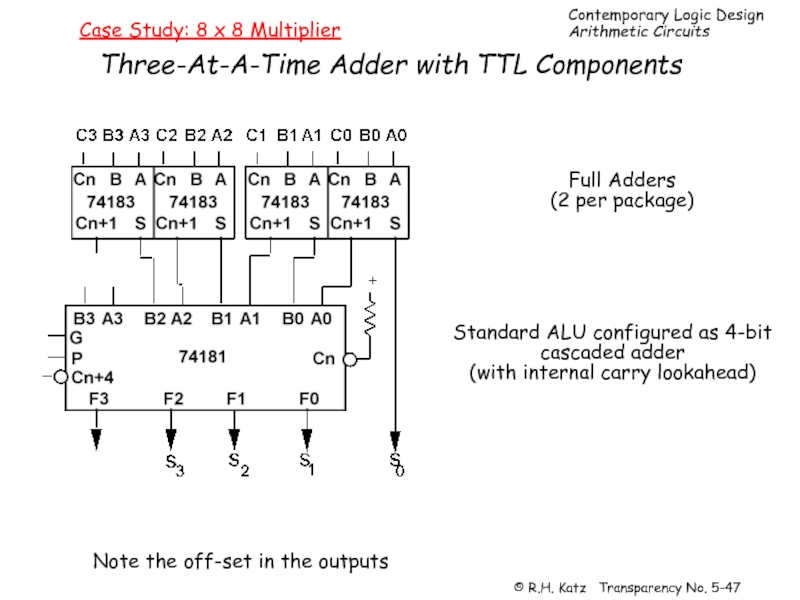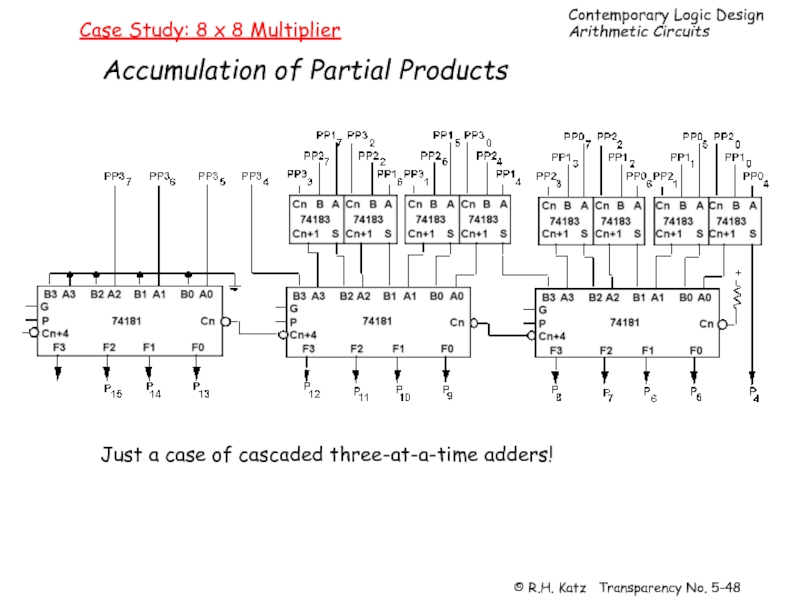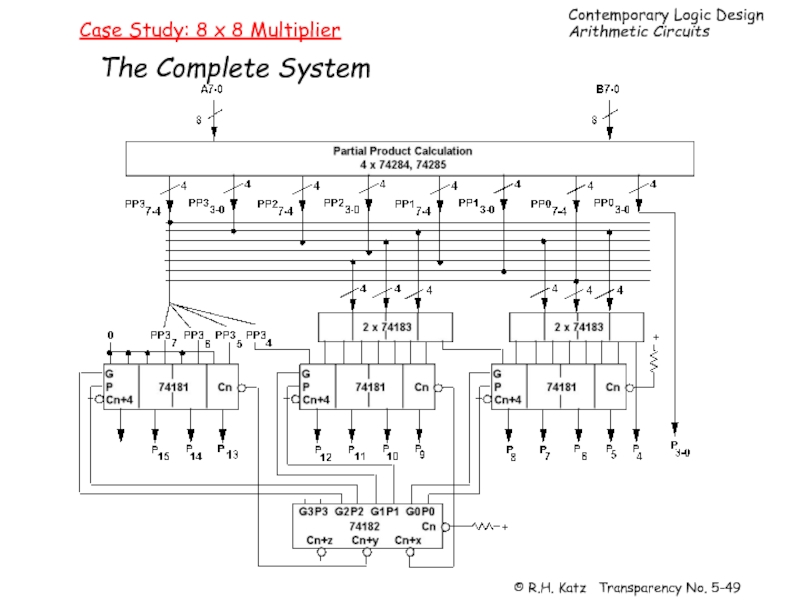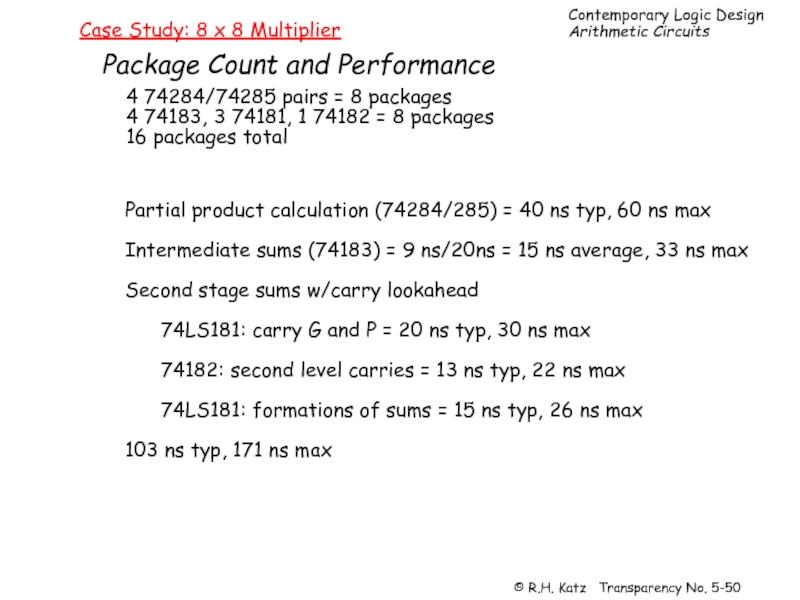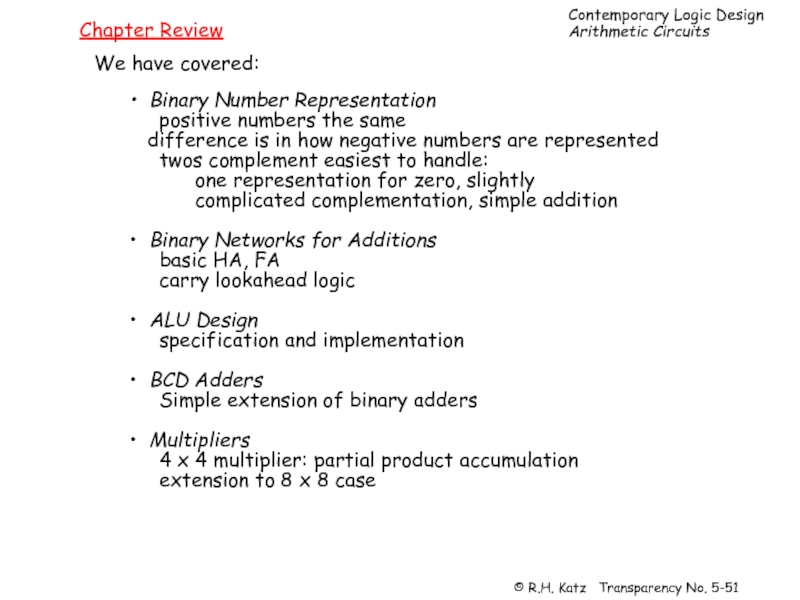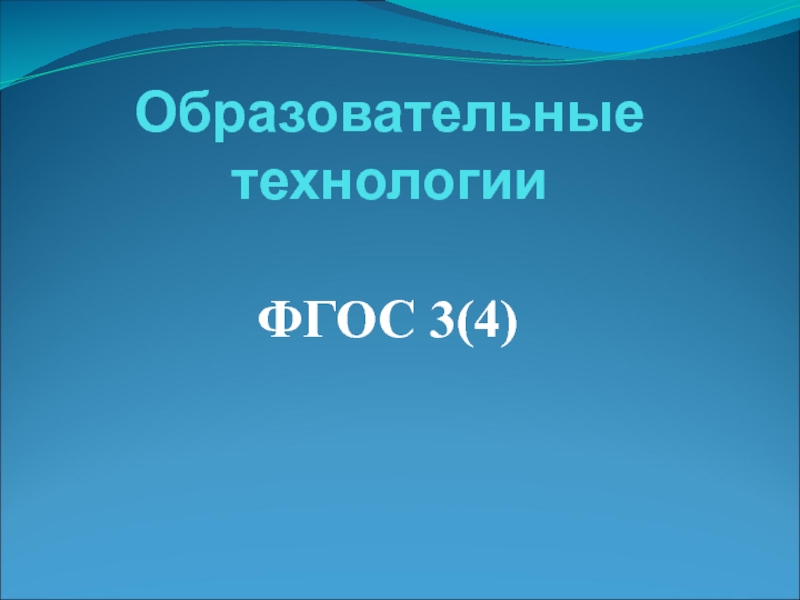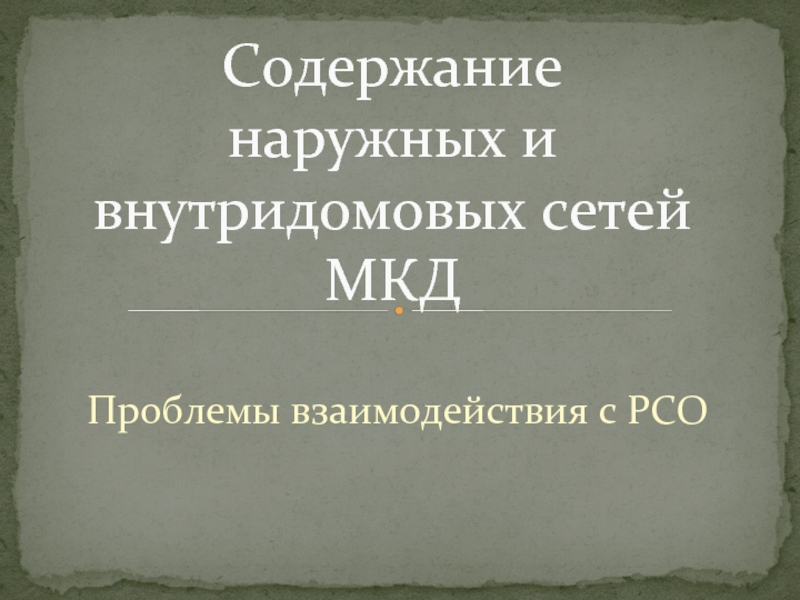- Главная
- Разное
- Дизайн
- Бизнес и предпринимательство
- Аналитика
- Образование
- Развлечения
- Красота и здоровье
- Финансы
- Государство
- Путешествия
- Спорт
- Недвижимость
- Армия
- Графика
- Культурология
- Еда и кулинария
- Лингвистика
- Английский язык
- Астрономия
- Алгебра
- Биология
- География
- Детские презентации
- Информатика
- История
- Литература
- Маркетинг
- Математика
- Медицина
- Менеджмент
- Музыка
- МХК
- Немецкий язык
- ОБЖ
- Обществознание
- Окружающий мир
- Педагогика
- Русский язык
- Технология
- Физика
- Философия
- Химия
- Шаблоны, картинки для презентаций
- Экология
- Экономика
- Юриспруденция
Chapter # 5: Arithmetic CircuitsContemporary Logic DesignRandy H. KatzUniversity of California, BerkeleyFall 2000 презентация
Содержание
- 1. Chapter # 5: Arithmetic CircuitsContemporary Logic DesignRandy H. KatzUniversity of California, BerkeleyFall 2000
- 2. Motivation Arithmetic circuits are excellent examples of
- 3. Chapter Overview Binary Number Representation
- 4. Number Systems Representation of Negative Numbers Representation
- 5. Number Systems Sign and Magnitude Representation High
- 6. Number Systems Sign and Magnitude Cumbersome addition/subtraction
- 7. Number Systems Ones Complement Subtraction implemented by
- 8. Number Representations Twos Complement Only one representation
- 9. Number Systems Twos Complement Numbers N* =
- 10. Number Representations Addition and Subtraction of Numbers
- 11. Number Systems Addition and Subtraction of Numbers
- 12. Number Systems Addition and Subtraction of Binary
- 13. Number Systems Addition and Subtraction of Binary
- 14. Number Systems Addition and Subtraction of Binary
- 15. Number Systems Overflow Conditions Add two positive
- 16. Number Systems Overflow Conditions 5 3
- 17. Networks for Binary Addition Half Adder With twos complement numbers, addition is sufficient Half-adder Schematic
- 18. Networks for Binary Addition Full Adder Cascaded
- 19. Networks for Binary Addition Full Adder S
- 20. Networks for Binary Addition Full Adder/Half Adder
- 21. Networks for Binary Addition Adder/Subtractor A -
- 22. Networks for Binary Addition Carry Lookahead Circuits
- 23. Networks for Binary Addition Carry Lookahead Circuits
- 24. Networks for Binary Addition Carry Lookahead Logic
- 25. Networks for Binary Addition Carry Lookahead Logic
- 26. Networks for Binary Addition Carry Lookahead Implementation
- 27. Networks for Binary Addition Carry Lookahead Logic
- 28. Networks for Binary Addition Carry Lookahead Logic
- 29. Networks for Binary Addition Carry Select Adder
- 30. Arithmetic Logic Unit Design Sample ALU Logical
- 31. Arithmetic Logic Unit Design Sample ALU Traditional
- 32. Arithmetic Logic Unit Design Sample ALU Multilevel
- 33. Arithmetic Logic Unit Design Clever Multi-level Logic
- 34. Arithmetic Logic Unit Design 74181 TTL ALU
- 35. Arithmetic Logic Unit Design 74181 TTL ALU
- 36. Arithmetic Logic Unit Design 16-bit ALU with Carry Lookahead
- 37. BCD Addition BCD Number Representation Decimal digits
- 38. BCD Addition Adder Design Add 0110 to sum whenever it exceeds 1001 (11XX or 1X1X)
- 39. Combinational Multiplier Basic Concept multiplicand multiplier
- 40. Combinational Multiplier Partial Product Accumulation A0
- 41. Combinational Multiplier Partial Product Accumulation Note use
- 42. Combinational Multiplier Another Representation of the Circuit
- 43. Case Study: 8 x 8 Multiplier TTL
- 44. Case Study: 8 x 8 Multiplier Problem
- 45. Case Study: 8 x 8 Multiplier Calculation
- 46. Case Study: 8 x 8 Multiplier Three-At-A-Time
- 47. Case Study: 8 x 8 Multiplier Three-At-A-Time
- 48. Case Study: 8 x 8 Multiplier Accumulation
- 49. Case Study: 8 x 8 Multiplier The Complete System
- 50. Case Study: 8 x 8 Multiplier Package
- 51. Chapter Review We have covered: • Binary
Слайд 1Chapter # 5: Arithmetic Circuits Contemporary Logic Design Randy H. Katz University of California,
Слайд 2Motivation
Arithmetic circuits are excellent examples of comb. logic design
• Time vs.
Doing things fast requires more logic and thus more space
Example: carry lookahead logic
• Arithmetic Logic Units
Critical component of processor datapath
Inner-most "loop" of most computer instructions
Слайд 3Chapter Overview
Binary Number Representation
Sign & Magnitude, Ones Complement, Twos
Binary Addition
Full Adder Revisted
ALU Design
BCD Circuits
Combinational Multiplier Circuit
Design Case Study: 8 Bit Multiplier
Слайд 4Number Systems
Representation of Negative Numbers
Representation of positive numbers same in most
Major differences are in how negative numbers are represented
Three major schemes:
sign and magnitude
ones complement
twos complement
Assumptions:
we'll assume a 4 bit machine word
16 different values can be represented
roughly half are positive, half are negative
Слайд 5Number Systems
Sign and Magnitude Representation
High order bit is sign: 0 =
Three low order bits is the magnitude: 0 (000) thru 7 (111)
Number range for n bits = +/-2 -1
Representations for 0
n-1
Слайд 6Number Systems
Sign and Magnitude
Cumbersome addition/subtraction
Must compare magnitudes to determine sign of
Ones Complement
N is positive number, then N is its negative 1's complement
N = (2 - 1) - N
n
Example: 1's complement of 7
2 = 10000
-1 = 00001
1111
-7 = 0111
1000
= -7 in 1's comp.
Shortcut method:
simply compute bit wise complement
0111 -> 1000
4
Слайд 7Number Systems
Ones Complement
Subtraction implemented by addition & 1's complement
Still two representations
Some complexities in addition
Слайд 8Number Representations
Twos Complement
Only one representation for 0
One more negative number than
like 1's comp
except shifted
one position
clockwise
Слайд 9Number Systems
Twos Complement Numbers
N* = 2 - N
n
Example: Twos complement
2 = 10000
7 = 0111
1001 = repr. of -7
Example: Twos complement of -7
4
2 = 10000
-7 = 1001
0111 = repr. of 7
4
sub
sub
Shortcut method:
Twos complement = bitwise complement + 1
0111 -> 1000 + 1 -> 1001 (representation of -7)
1001 -> 0110 + 1 -> 0111 (representation of 7)
Слайд 10Number Representations
Addition and Subtraction of Numbers
Sign and Magnitude
4
+ 3
7
0100
0011
0111
-4
+ (-3)
-7
1100
1011
1111
result sign
same as the operands'
sign
4
- 3
1
0100
1011
0001
-4
+ 3
-1
1100
0011
1001
when signs differ,
operation is subtract,
sign of result depends
on sign of number with
the larger magnitude
Слайд 11Number Systems
Addition and Subtraction of Numbers
Ones Complement Calculations
4
+ 3
7
0100
0011
0111
-4
+ (-3)
-7
1011
1100
10111
1
1000
4
- 3
1
0100
1100
10000
1
0001
-4
+
-1
1011
0011
1110
End around carry
End around carry
Слайд 12Number Systems
Addition and Subtraction of Binary Numbers
Ones Complement Calculations
Why does end-around
Its equivalent to subtracting 2 and adding 1
n
M - N = M + N = M + (2 - 1 - N) = (M - N) + 2 - 1
n
n
(M > N)
-M + (-N) = M + N = (2 - M - 1) + (2 - N - 1)
= 2 + [2 - 1 - (M + N)] - 1
n
n
n
n
M + N < 2
n-1
after end around carry:
= 2 - 1 - (M + N)
n
this is the correct form for representing -(M + N) in 1's comp!
Слайд 13Number Systems
Addition and Subtraction of Binary Numbers
Twos Complement Calculations
4
+ 3
7
0100
0011
0111
-4
+ (-3)
-7
1100
1101
11001
4
-
1
0100
1101
10001
-4
+ 3
-1
1100
0011
1111
If carry-in to sign =
carry-out then ignore
carry
if carry-in differs from
carry-out then overflow
Simpler addition scheme makes twos complement the most common
choice for integer number systems within digital systems
Слайд 14Number Systems
Addition and Subtraction of Binary Numbers
Twos Complement Calculations
Why can the
-M + N when N > M:
M* + N = (2 - M) + N = 2 + (N - M)
n
n
Ignoring carry-out is just like subtracting 2
n
-M + -N where N + M < or = 2
n-1
-M + (-N) = M* + N* = (2 - M) + (2 - N)
= 2 - (M + N) + 2
n
n
After ignoring the carry, this is just the right twos compl.
representation for -(M + N)!
n
n
Слайд 15Number Systems
Overflow Conditions
Add two positive numbers to get a negative number
or
5 + 3 = -9
-7 - 2 = +7
0000
0001
0010
0011
1000
0101
0110
0100
1001
1010
1011
1100
1101
0111
1110
1111
+0
+1
+2
+3
+4
+5
+6
+7
-8
-7
-6
-5
-4
-3
-2
-1
0000
0001
0010
0011
1000
0101
0110
0100
1001
1010
1011
1100
1101
0111
1110
1111
+0
+1
+2
+3
+4
+5
+6
+7
-8
-7
-6
-5
-4
-3
-2
-1
Слайд 16Number Systems
Overflow Conditions
5
3
-8
0 1 1 1
0 1 0 1
1 0 0 0
-7
-2
7
1 0 0 0
1 0 0 1
1 1 0 0
1 0 1 1 1
5
2
7
0 0 0 0
0 1 0 1
0 0 1 0
0 1 1 1
-3
-5
-8
1 1 1 1
1 1 0 1
1 0 1 1
1 1 0 0 0
Overflow
Overflow
No overflow
No overflow
Overflow when carry in to sign does not equal carry out
Слайд 17Networks for Binary Addition
Half Adder
With twos complement numbers, addition is sufficient
Half-adder
Слайд 18Networks for Binary Addition
Full Adder
Cascaded Multi-bit
Adder
usually interested in adding more
this motivates the need for the full adder
Слайд 19Networks for Binary Addition
Full Adder
S = CI xor A xor B
CO
Слайд 20Networks for Binary Addition
Full Adder/Half Adder
Alternative Implementation: 5 Gates
A B +
Standard Approach: 6 Gates
+
Слайд 22Networks for Binary Addition
Carry Lookahead Circuits
Critical delay: the propagation of carry
late
arriving
signal
two gate delays
to compute CO
4 stage
adder
final sum and
carry
Слайд 23Networks for Binary Addition
Carry Lookahead Circuits
Critical delay: the propagation of carry
1111 + 0001
worst case
addition
T0: Inputs to the adder are valid
T2: Stage 0 carry out (C1)
T4: Stage 1 carry out (C2)
T6: Stage 2 carry out (C3)
T8: Stage 3 carry out (C4)
2 delays to compute sum
but last carry not ready
until 6 delays later
Слайд 24Networks for Binary Addition
Carry Lookahead Logic
Carry Generate Gi = Ai Bi
Carry Propagate Pi = Ai xor Bi carry in will equal carry out here
Si = Ai xor Bi xor Ci = Pi xor Ci
Ci+1 = Ai Bi + Ai Ci + Bi Ci
= Ai Bi + Ci (Ai + Bi)
= Ai Bi + Ci (Ai xor Bi)
= Gi + Ci Pi
Sum and Carry can be reexpressed in terms of generate/propagate:
Слайд 25Networks for Binary Addition
Carry Lookahead Logic
Reexpress the carry logic as follows:
C1
C2 = G1 + P1 C1 = G1 + P1 G0 + P1 P0 C0
C3 = G2 + P2 C2 = G2 + P2 G1 + P2 P1 G0 + P2 P1 P0 C0
C4 = G3 + P3 C3 = G3 + P3 G2 + P3 P2 G1 + P3 P2 P1 G0 + P3 P2 P1 P0 C0
Each of the carry equations can be implemented in a two-level logic
network
Variables are the adder inputs and carry in to stage 0!
Слайд 26Networks for Binary Addition
Carry Lookahead Implementation
Adder with Propagate and
Generate Outputs
Increasingly
Слайд 27Networks for Binary Addition
Carry Lookahead Logic
Cascaded Carry Lookahead
Carry lookahead
logic generates
individual carries
sums
much faster
Слайд 28Networks for Binary Addition
Carry Lookahead Logic
Cascaded Carry Lookahead
4 bit adders with
second level carry lookahead unit, extends lookahead to 16 bits
Слайд 29Networks for Binary Addition
Carry Select Adder
Redundant hardware to make carry calculation
compute the high order sums in parallel
one addition assumes carry in = 0
the other assumes carry in = 1
Слайд 30Arithmetic Logic Unit Design
Sample ALU
Logical and Arithmetic Operations
Not all operations appear
Слайд 31Arithmetic Logic Unit Design
Sample ALU
Traditional Design Approach
Truth Table & Espresso
23 product
Equivalent to
25 gates
.i 6
.o 2
.ilb m s1 s0 ci ai bi
.ob fi co
.p 23
111101 10
110111 10
1-0100 10
1-1110 10
10010- 10
10111- 10
-10001 10
010-01 10
-11011 10
011-11 10
--1000 10
0-1-00 10
--0010 10
0-0-10 10
-0100- 10
001-0- 10
-0001- 10
000-1- 10
-1-1-1 01
--1-01 01
--0-11 01
--110- 01
--011- 01
.e
Слайд 32Arithmetic Logic Unit Design
Sample ALU
Multilevel Implementation
.model alu.espresso
.inputs m s1 s0 ci
.outputs fi co
.names m ci co [30] [33] [35] fi
110--- 1
-1-11- 1
--01-1 1
--00-0 1
.names m ci [30] [33] co
-1-1 1
--11 1
111- 1
.names s0 ai [30]
01 1
10 1
.names m s1 bi [33]
111 1
.names s1 bi [35]
0- 1
-0 1
.end
12 Gates
Слайд 33Arithmetic Logic Unit Design
Clever Multi-level Logic Implementation
Sample ALU
8 Gates (but 3
S1 = 0 blocks Bi
Happens when operations involve Ai
only
Same is true for Ci when M = 0
Addition happens when M = 1
Bi, Ci to Xor gates X2, X3
S0 = 0, X1 passes A
S0 = 1, X1 passes A
Arithmetic Mode:
Or gate inputs are Ai Ci and
Bi (Ai xor Ci)
Logic Mode:
Cascaded XORs form output from
Ai and Bi
Слайд 35Arithmetic Logic Unit Design
74181 TTL ALU
Note that the sense of the
OPPOSITE from the input bits
Fortunately, carry lookahead generator
maintains the correct sense of the signals
Слайд 37BCD Addition
BCD Number Representation
Decimal digits 0 thru 9 represented as 0000
Addition:
5 = 0101
3 = 0011
1000 = 8
5 = 0101
8 = 1000
1101 = 13!
Problem
when digit
sum exceeds 9
Solution: add 6 (0110) if sum exceeds 9!
5 = 0101
8 = 1000
1101
6 = 0110
1 0011 = 1 3 in BCD
9 = 1001
7 = 0111
1 0000 = 16 in binary
6 = 0110
1 0110 = 1 6 in BCD
Слайд 39Combinational Multiplier
Basic Concept
multiplicand
multiplier
1101 (13)
1011 (11)
1101
1101
0000
1101
*
10001111
(143)
Partial products
product of 2 4-bit
is an 8-bit number
Слайд 40Combinational Multiplier
Partial Product Accumulation
A0
B0
A0 B0
A1
B1
A1 B0
A0 B1
A2
B2
A2 B0
A1 B1
A0 B2
A3
B3
A2 B0
A2
A1 B2
A0 B3
A3 B1
A2 B2
A1 B3
A3 B2
A2 B3
A3 B3
S6
S5
S4
S3
S2
S1
S0
S7
Слайд 41Combinational Multiplier
Partial Product Accumulation
Note use of parallel carry-outs to form higher
12 Adders, if full adders, this is 6 gates each = 72 gates
16 gates form the partial products
total = 88 gates!
Слайд 42Combinational Multiplier
Another Representation of the Circuit
Building block: full adder + and
4
Слайд 44Case Study: 8 x 8 Multiplier
Problem Decomposition
How to implement 8 x
A7-4
B7-4
A3-0
B3-0
*
A3-0 * B3-0
A7-4 * B3-0
A3-0 * B7-4
A7-4 * B7-4
= PP0
= PP1
= PP2
= PP3
P15-12 P11-8 P7-4 P3-0
8 bit products
P3-0 = PP0
P7-4 = PP0 + PP1 + PP2
P11-8 = PP1 + PP2 + PP3
P15-12 = PP3
3-0
3-0
3-0
3-0
7-4
7-4
3-0
7-4
+ Carry-in
+ Carry-in
+ Carry-in
Слайд 45Case Study: 8 x 8 Multiplier
Calculation of Partial Products
Use 4 74284/285
Слайд 46Case Study: 8 x 8 Multiplier
Three-At-A-Time Adder
Clever use of the Carry
Sum A[3-0], B[3-0], C[3-0]:
Two Level Full Adder Circuit
Note: Carry lookahead schemes also possible!
Слайд 47Case Study: 8 x 8 Multiplier
Three-At-A-Time Adder with TTL Components
Full Adders
(2
Standard ALU configured as 4-bit
cascaded adder
(with internal carry lookahead)
Note the off-set in the outputs
Слайд 48Case Study: 8 x 8 Multiplier
Accumulation of Partial Products
Just a case
Слайд 50Case Study: 8 x 8 Multiplier
Package Count and Performance
4 74284/74285 pairs
4 74183, 3 74181, 1 74182 = 8 packages
16 packages total
Partial product calculation (74284/285) = 40 ns typ, 60 ns max
Intermediate sums (74183) = 9 ns/20ns = 15 ns average, 33 ns max
Second stage sums w/carry lookahead
74LS181: carry G and P = 20 ns typ, 30 ns max
74182: second level carries = 13 ns typ, 22 ns max
74LS181: formations of sums = 15 ns typ, 26 ns max
103 ns typ, 171 ns max
Слайд 51Chapter Review
We have covered:
• Binary Number Representation
positive numbers
difference is in how negative numbers are represented
twos complement easiest to handle:
one representation for zero, slightly
complicated complementation, simple addition
• Binary Networks for Additions
basic HA, FA
carry lookahead logic
• ALU Design
specification and implementation
• BCD Adders
Simple extension of binary adders
• Multipliers
4 x 4 multiplier: partial product accumulation
extension to 8 x 8 case
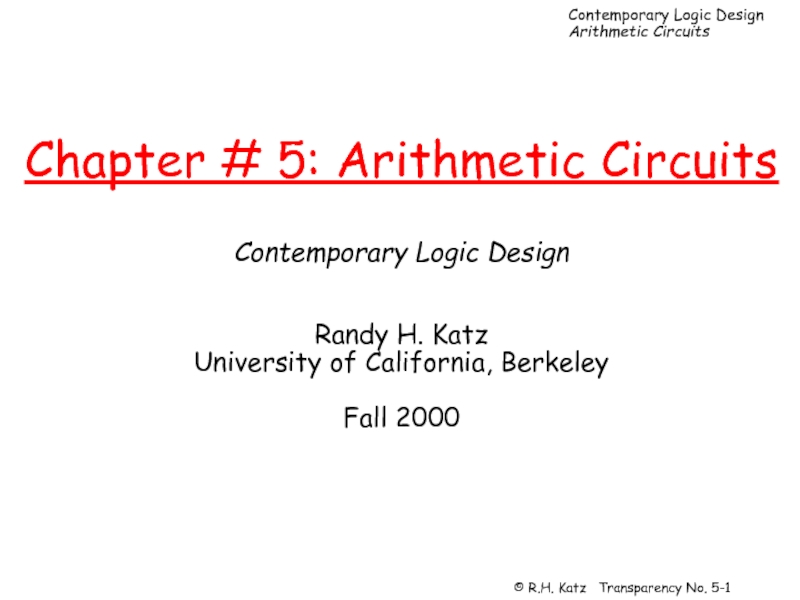
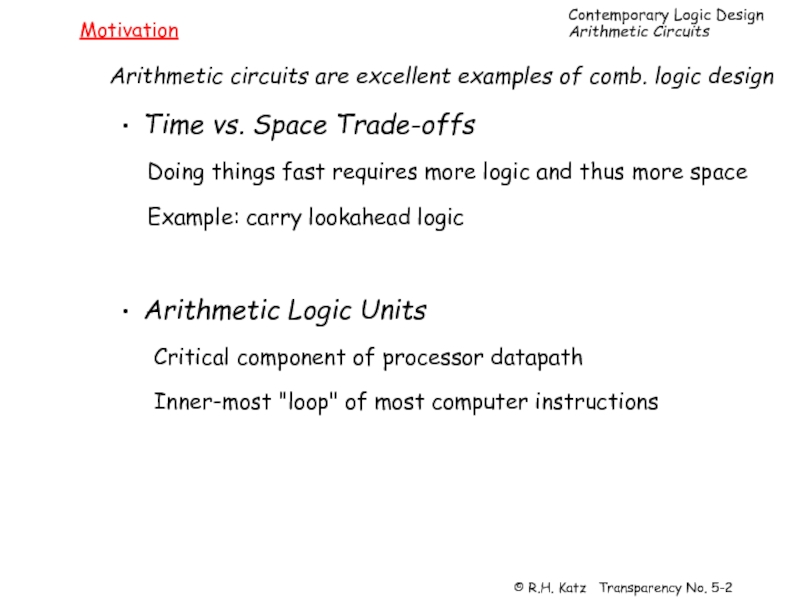
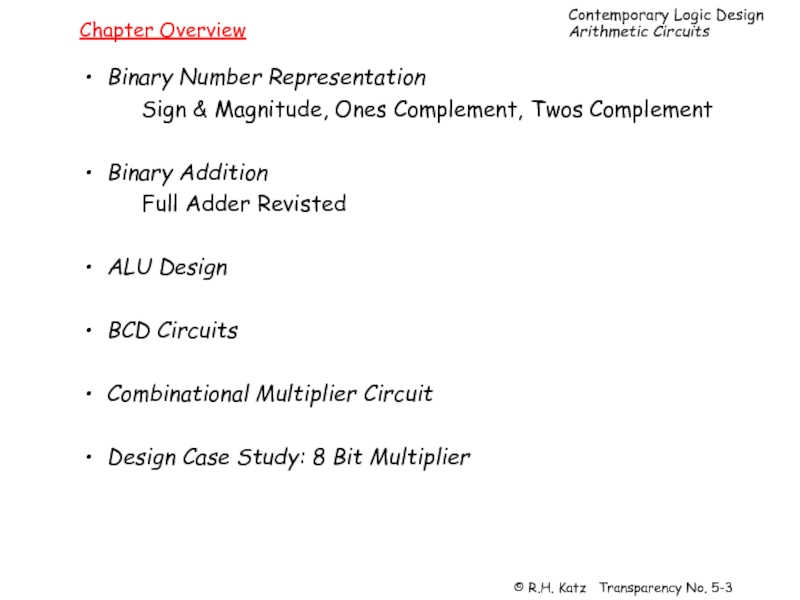
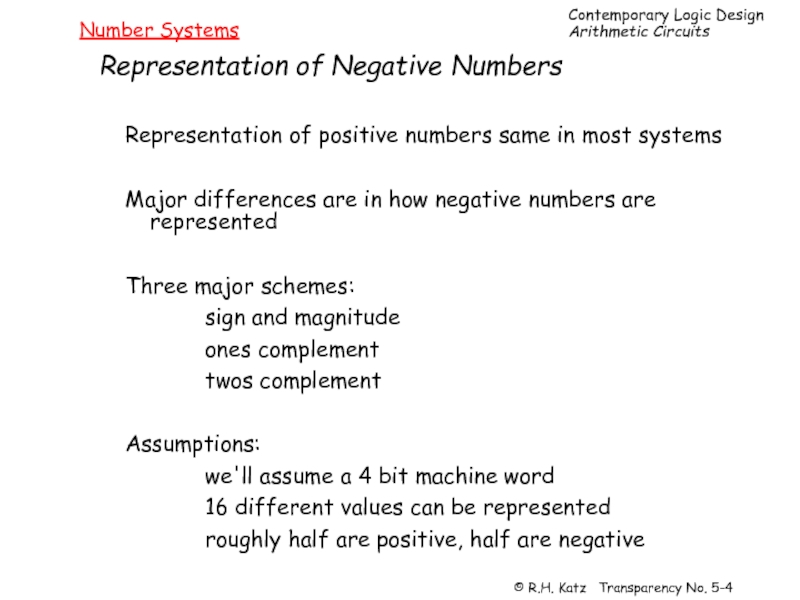
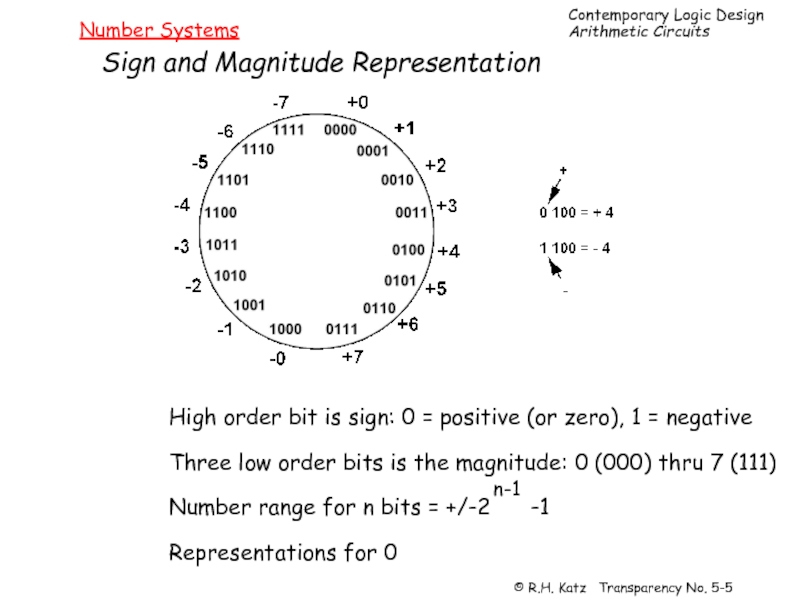
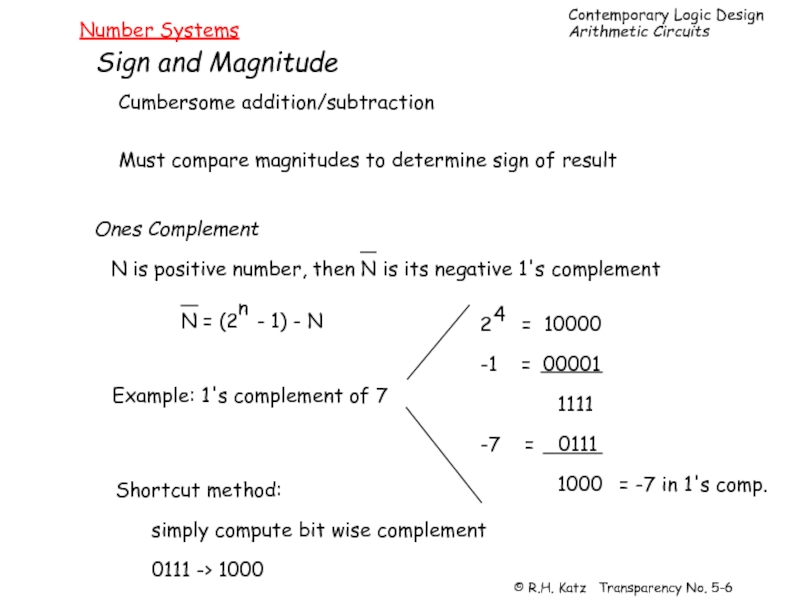
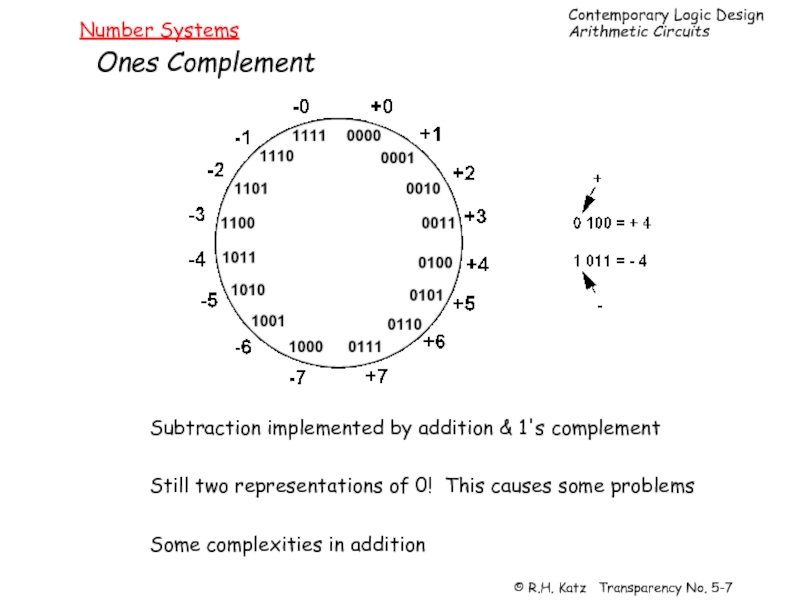
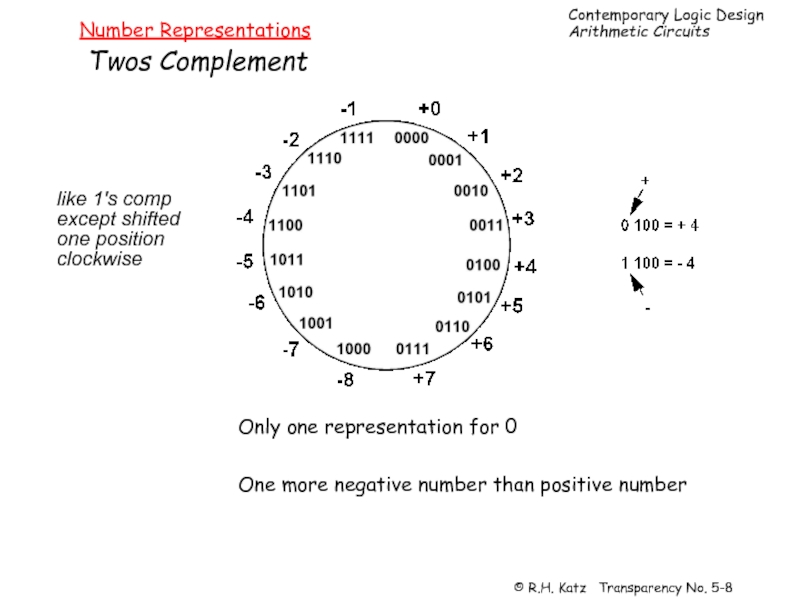
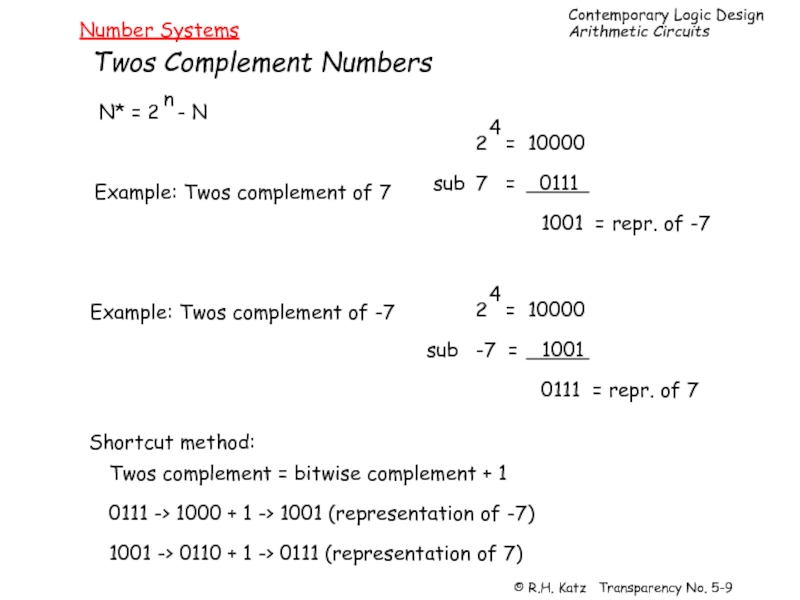
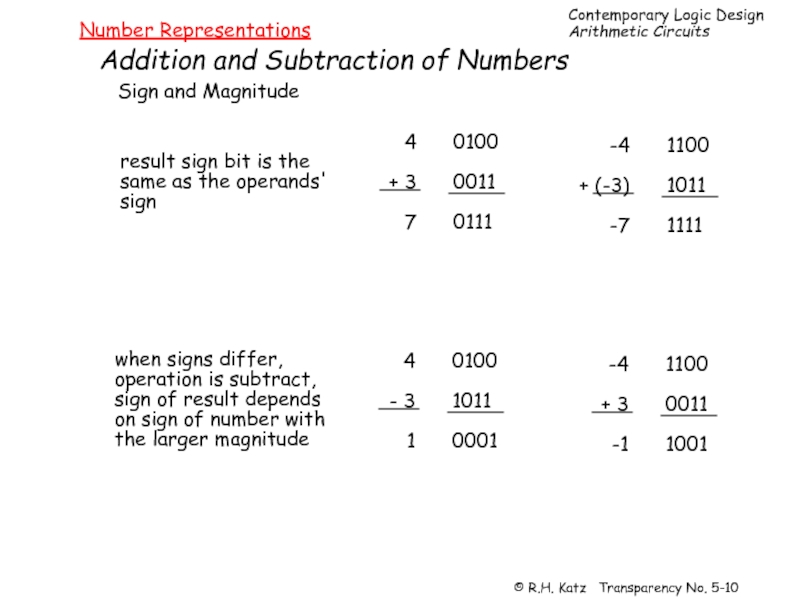
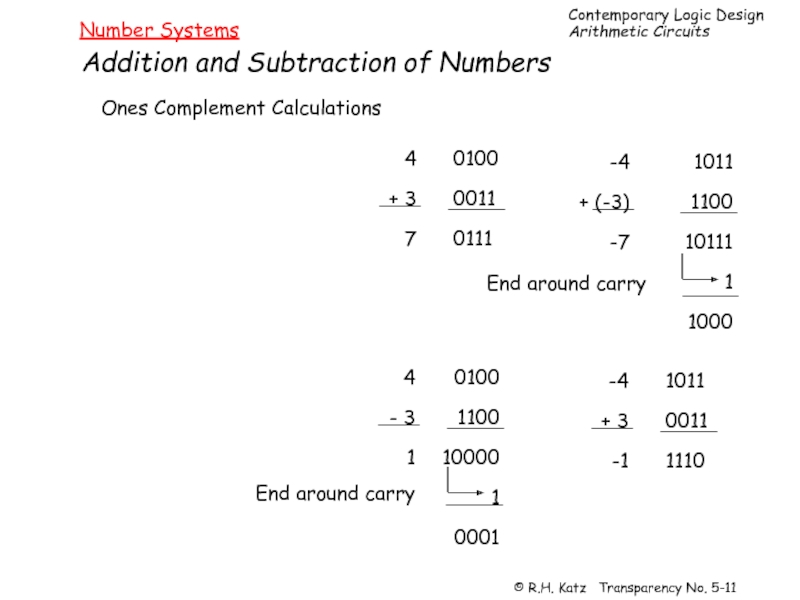
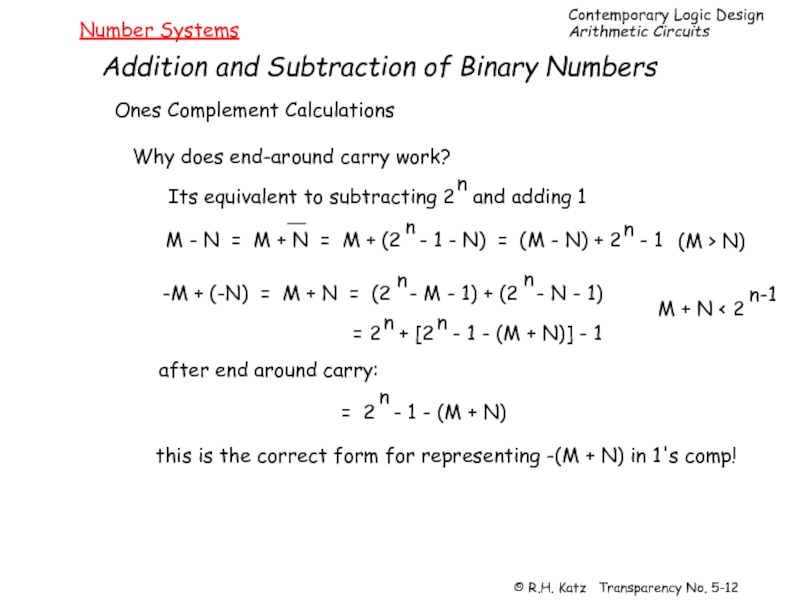
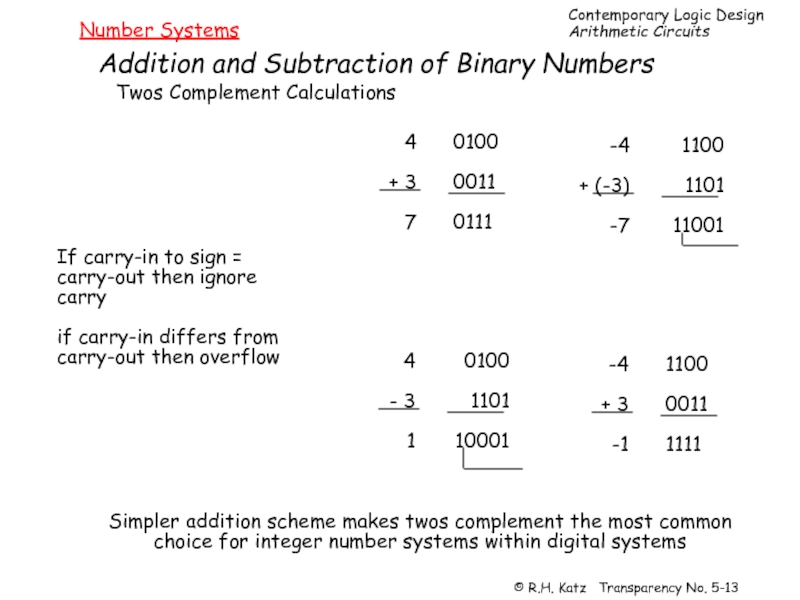
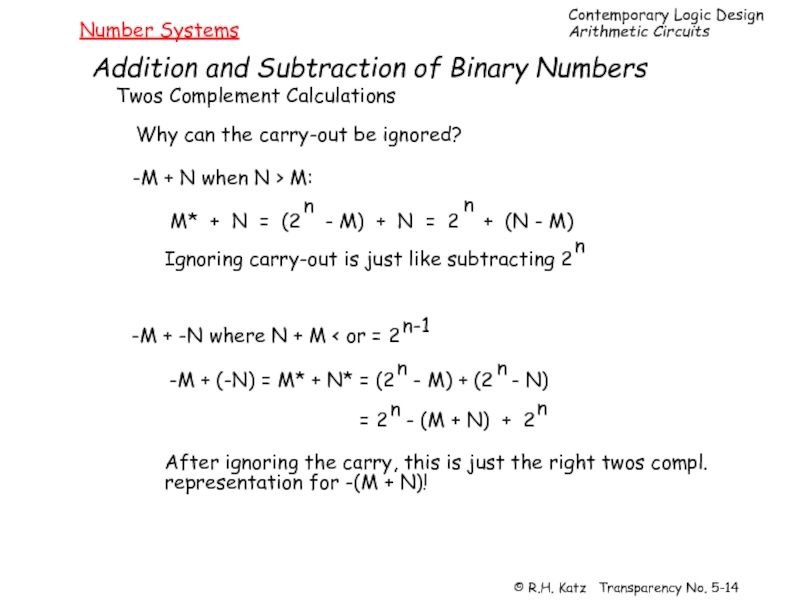
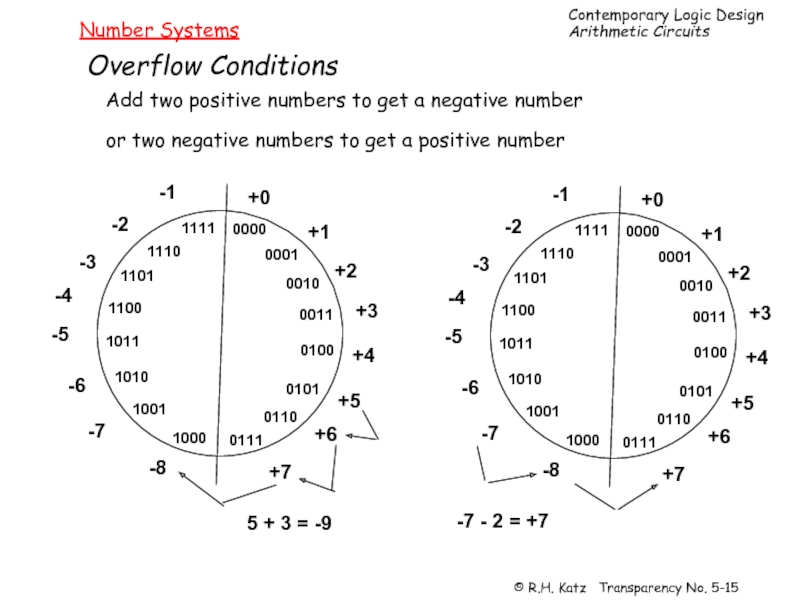
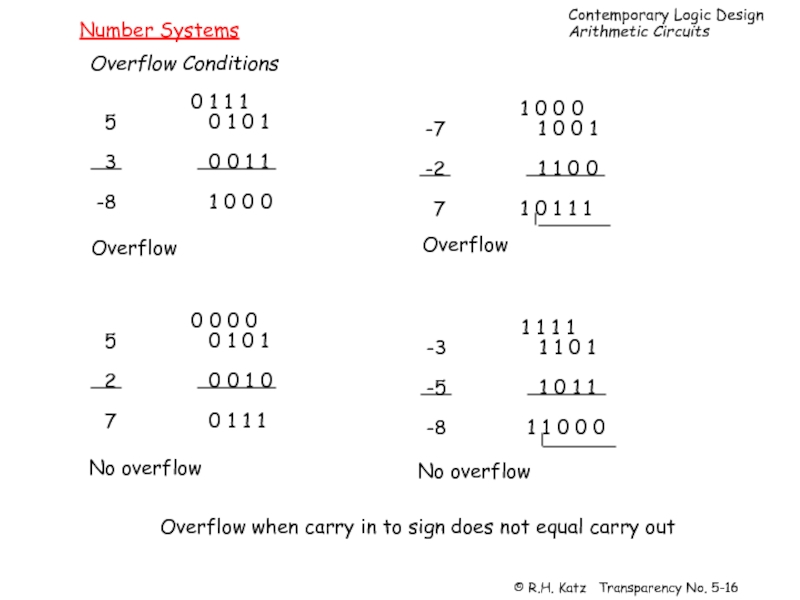
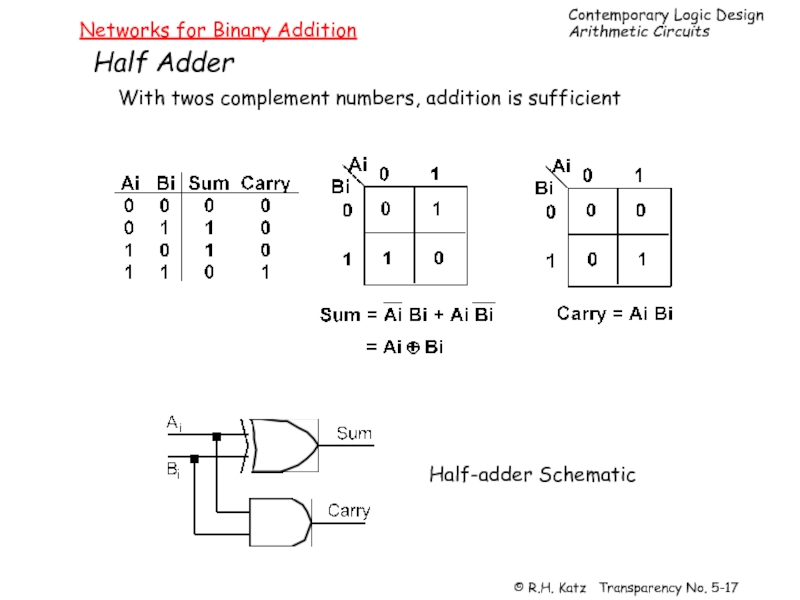
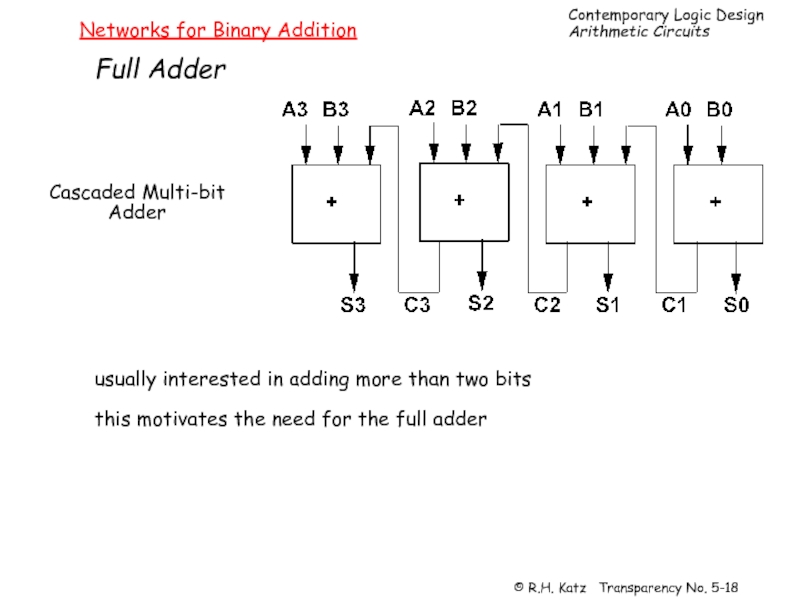
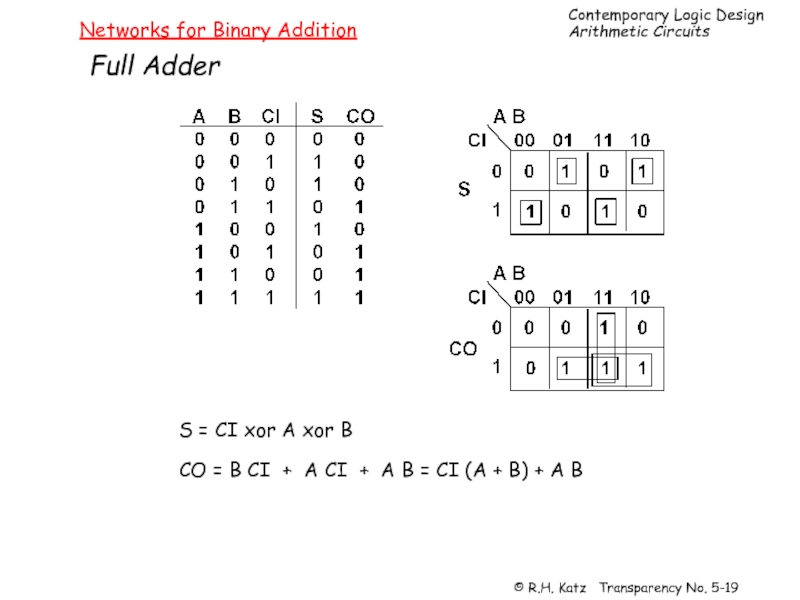
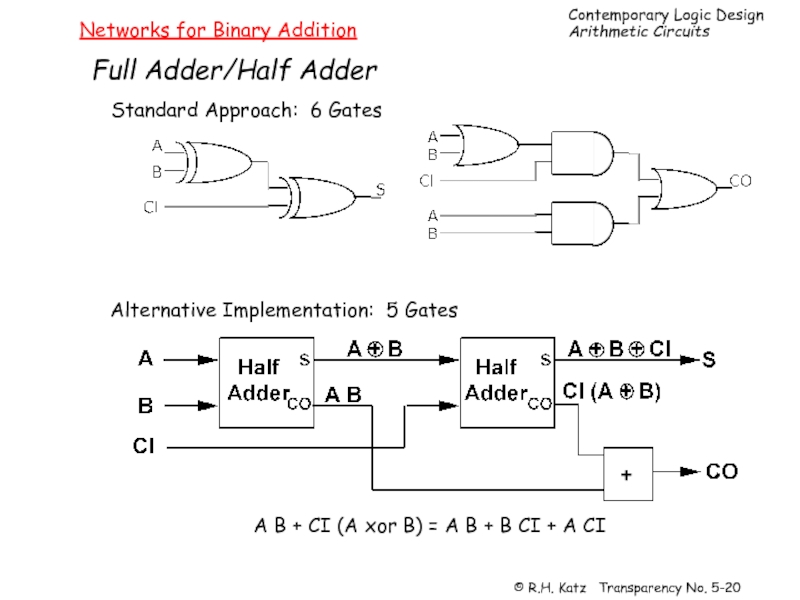
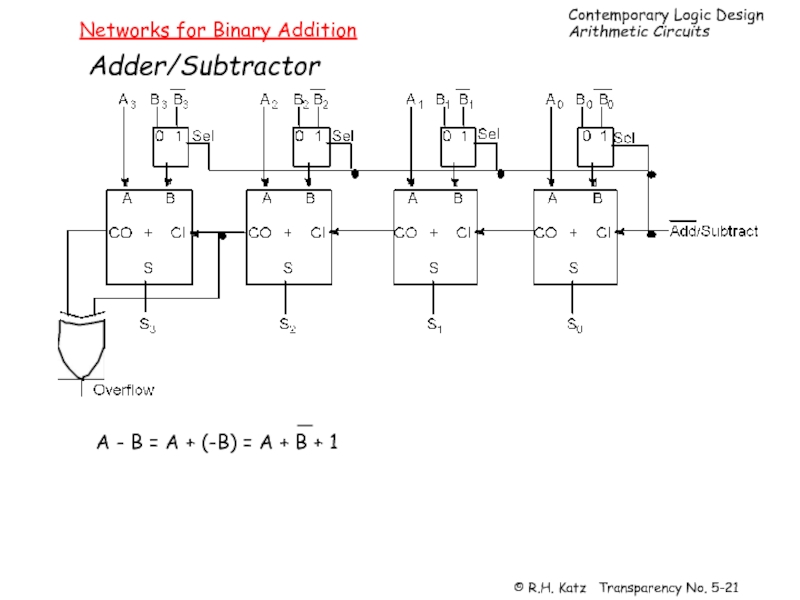
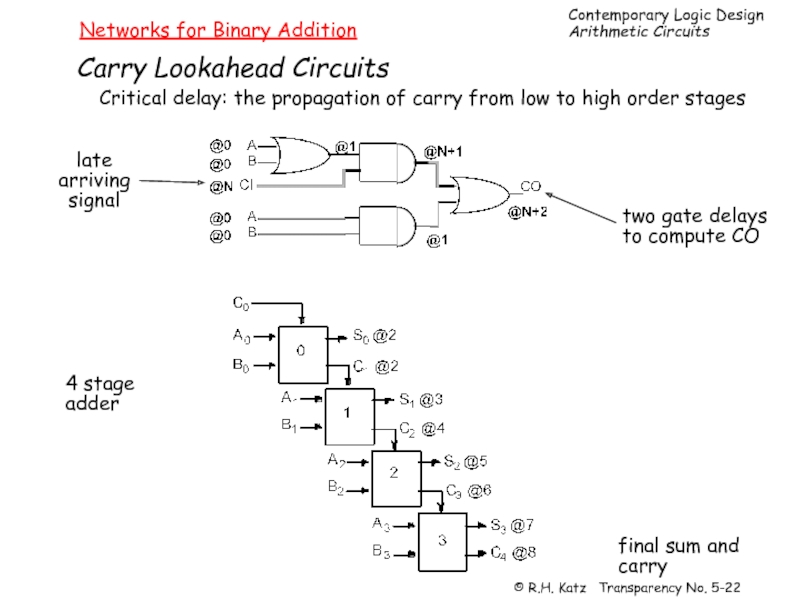
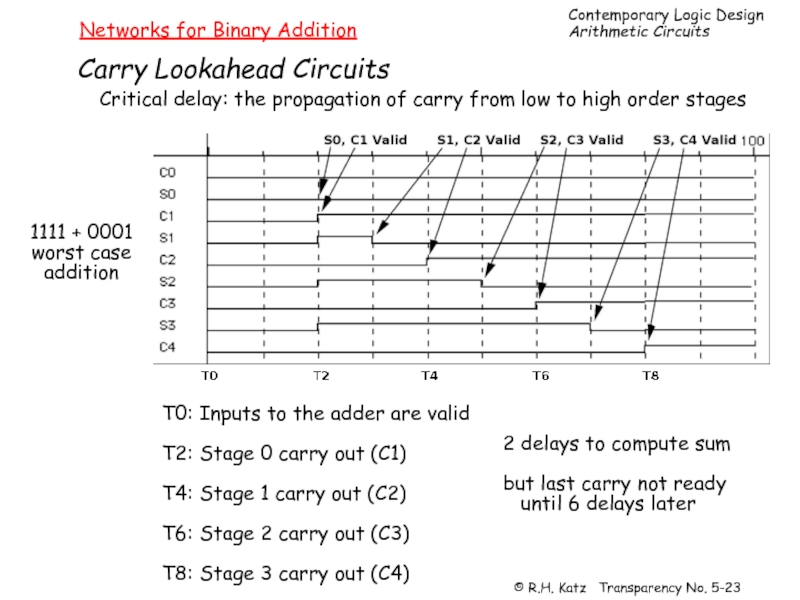
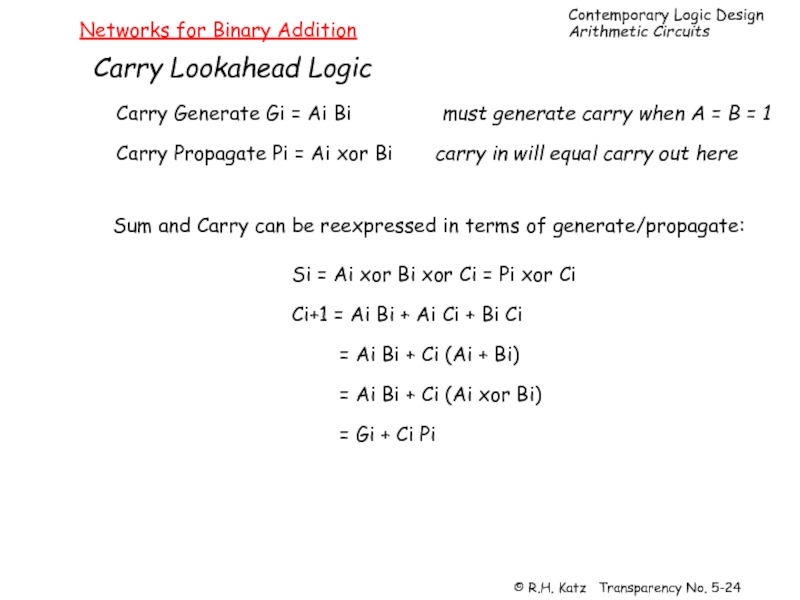
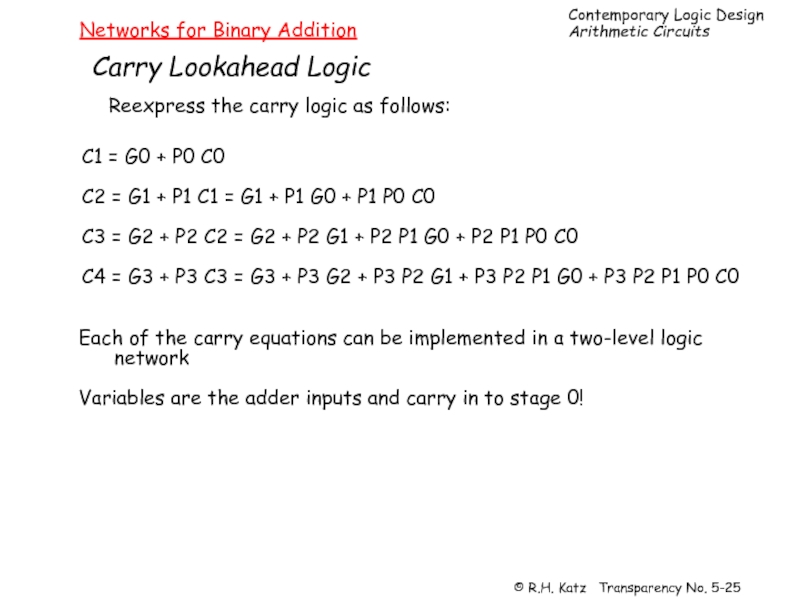
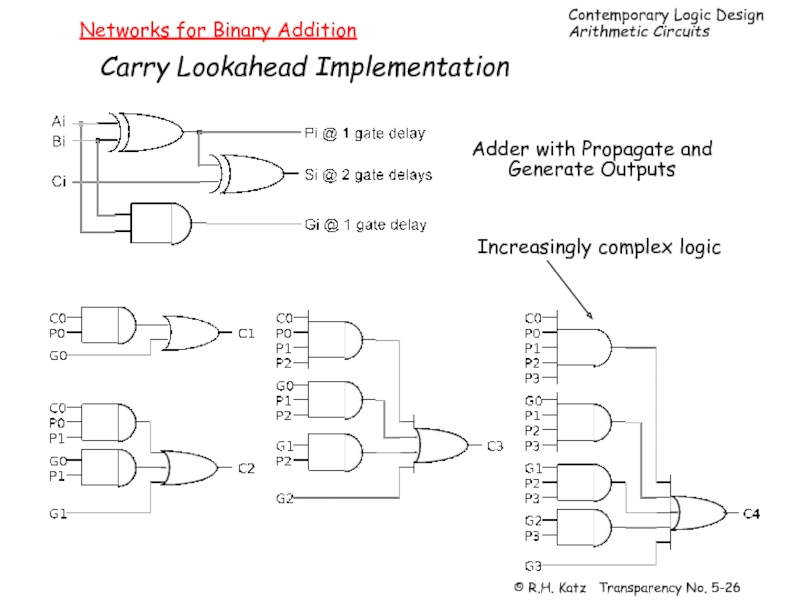
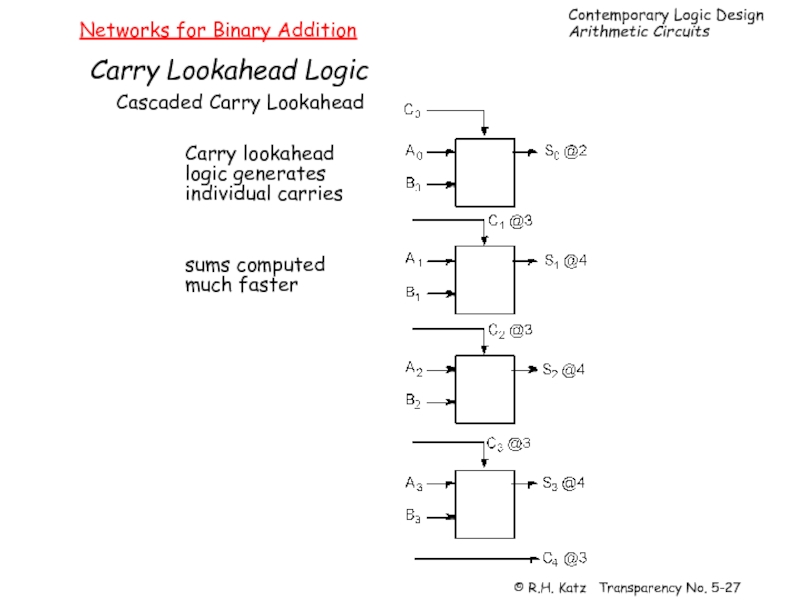
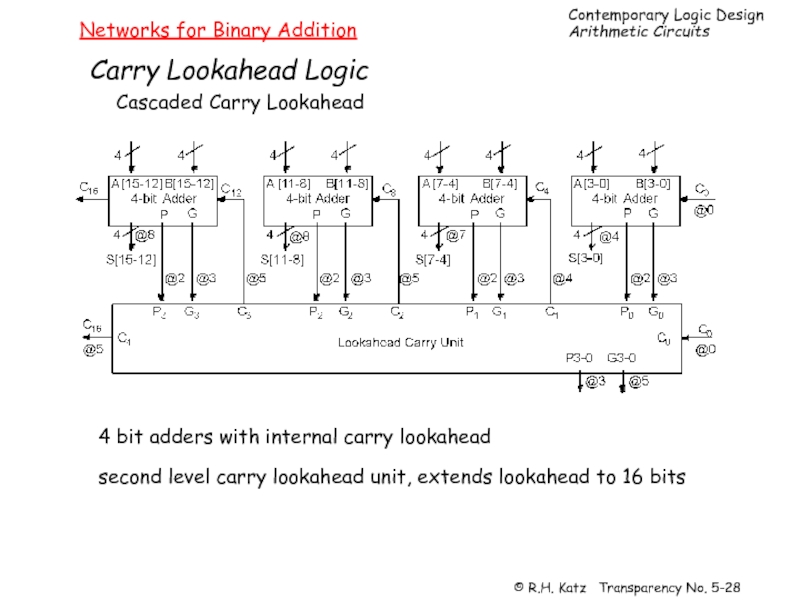
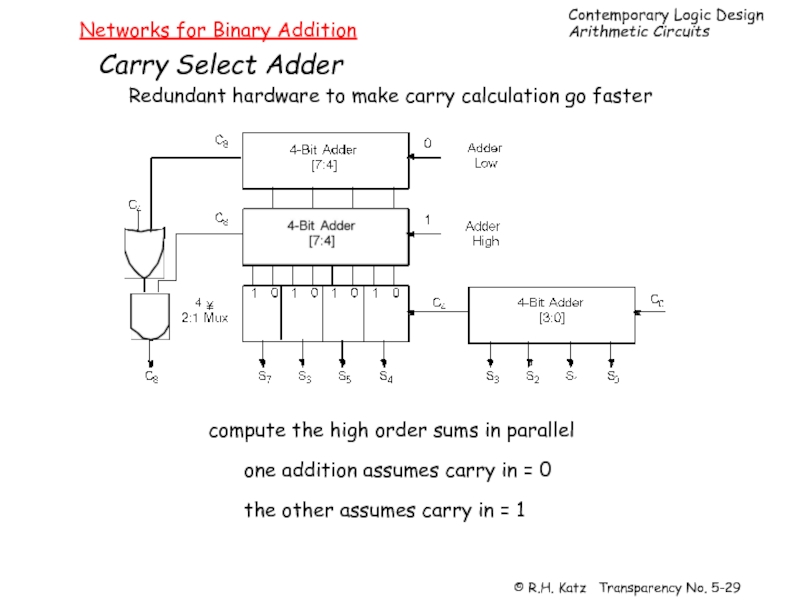
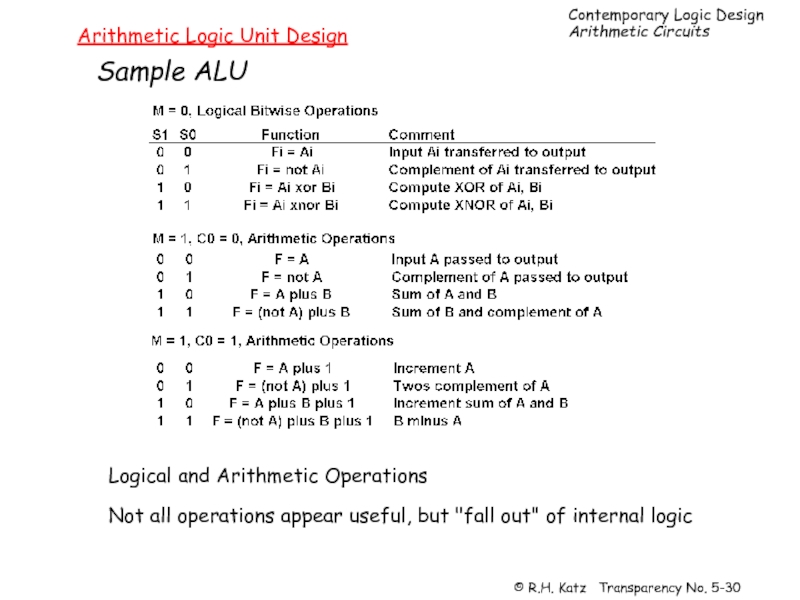
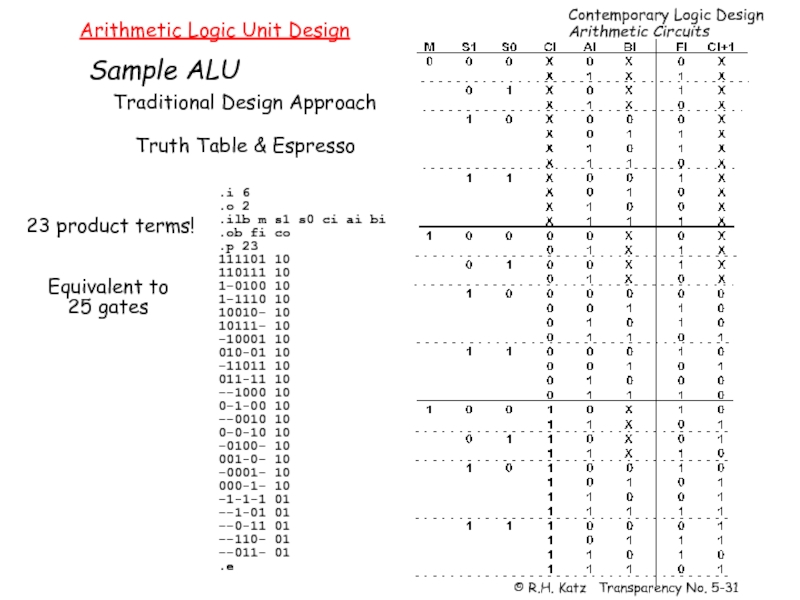
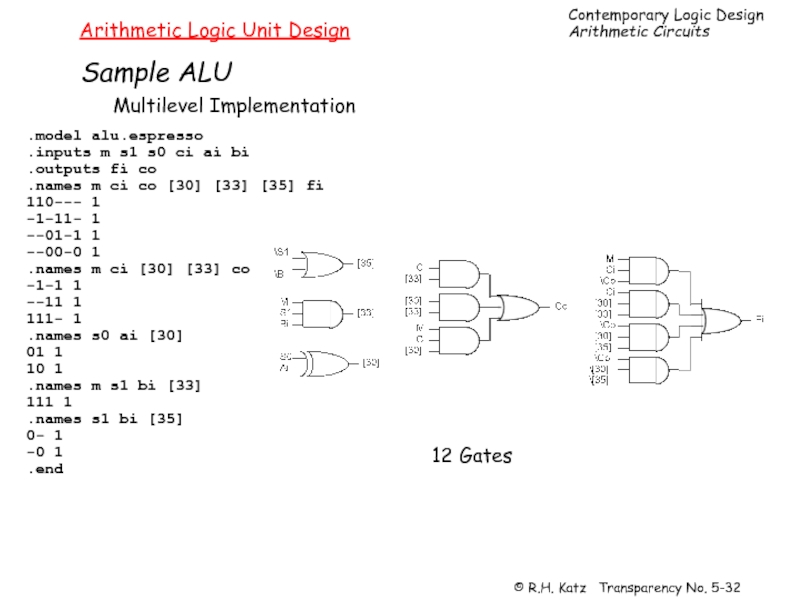
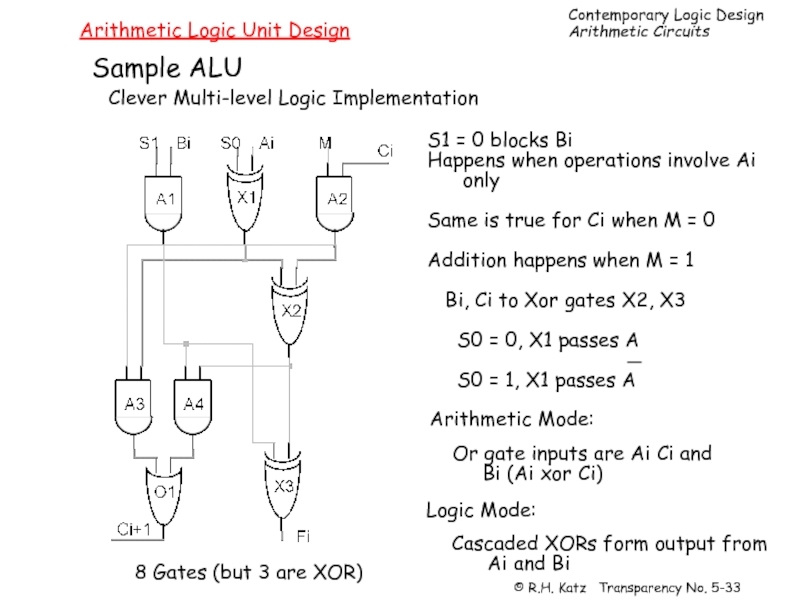
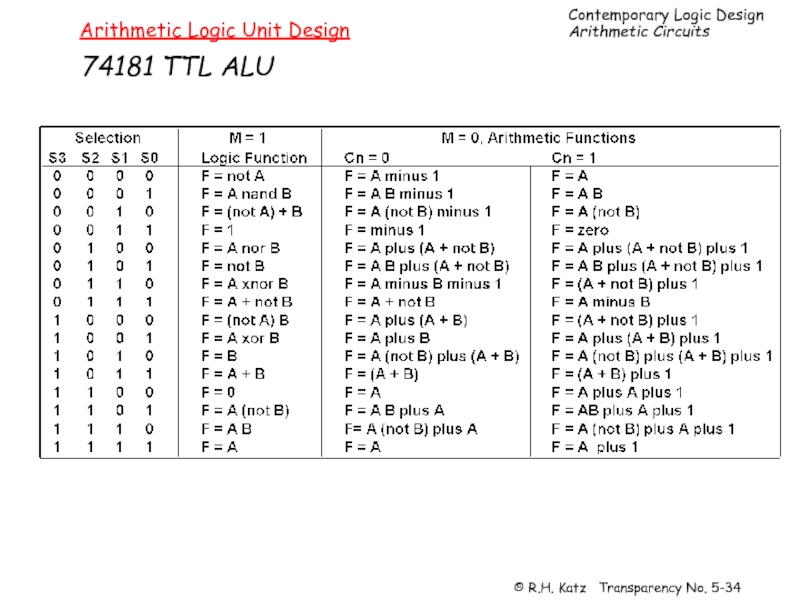
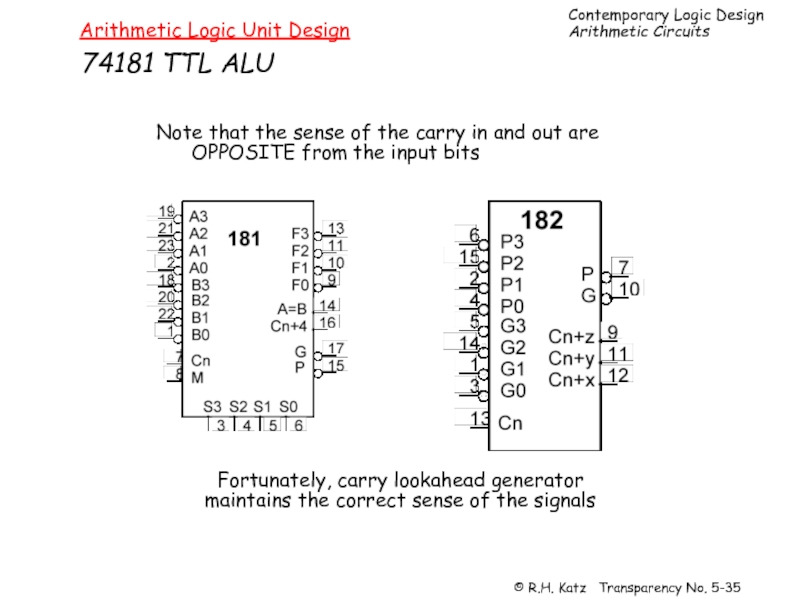
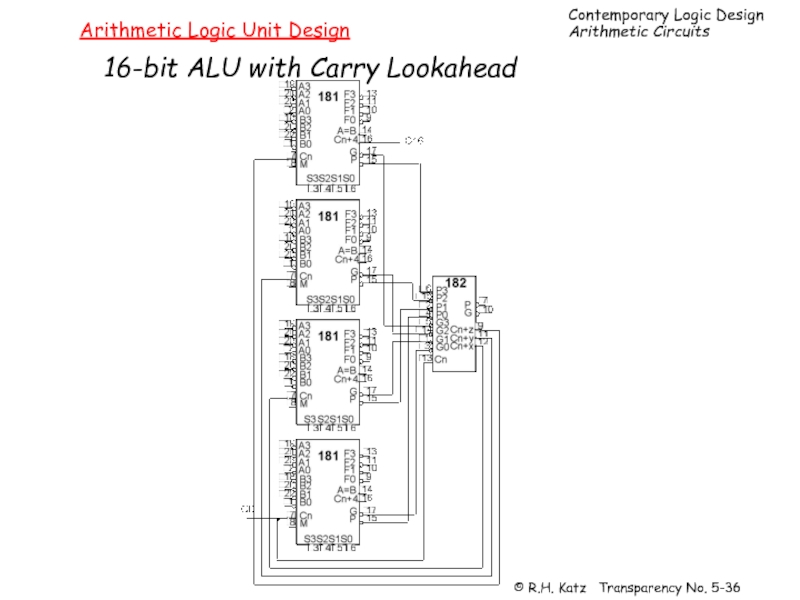
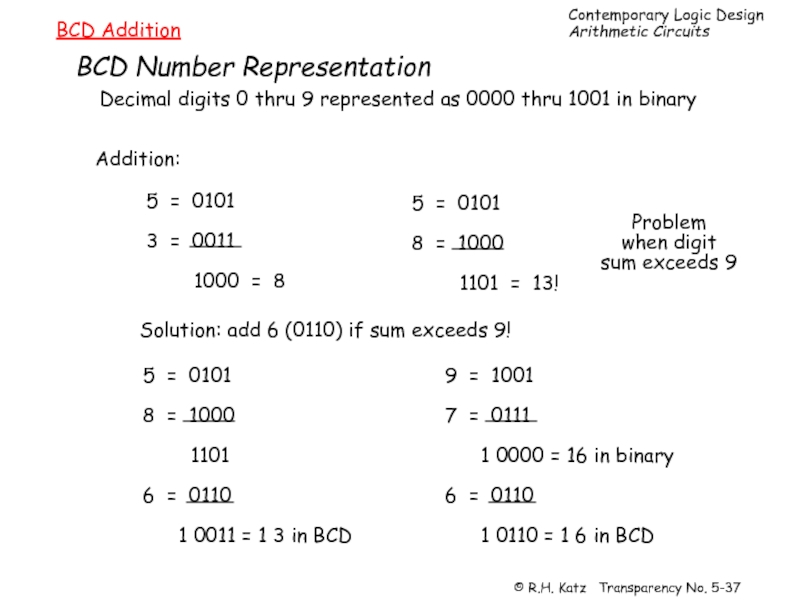
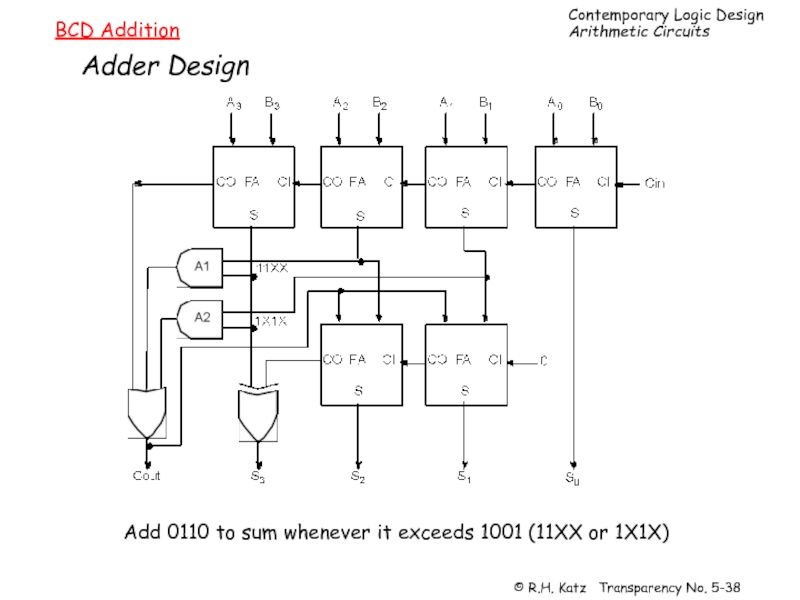
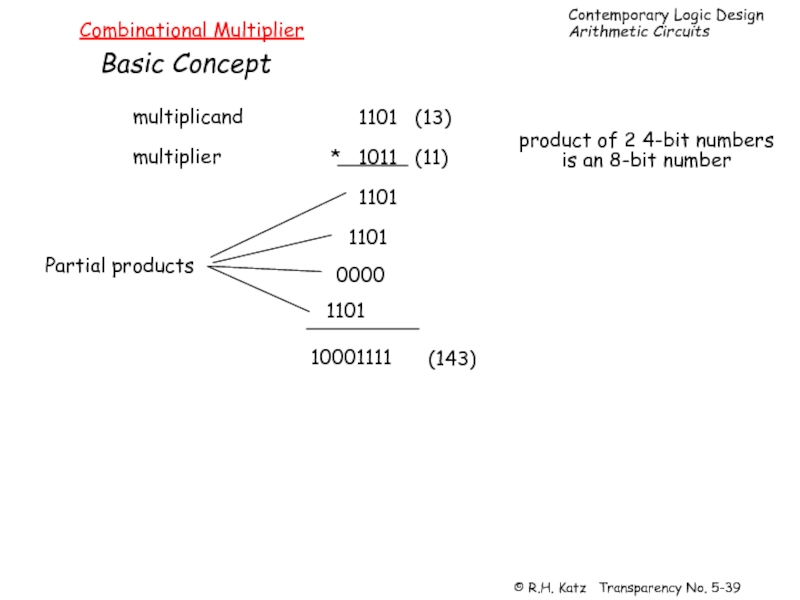
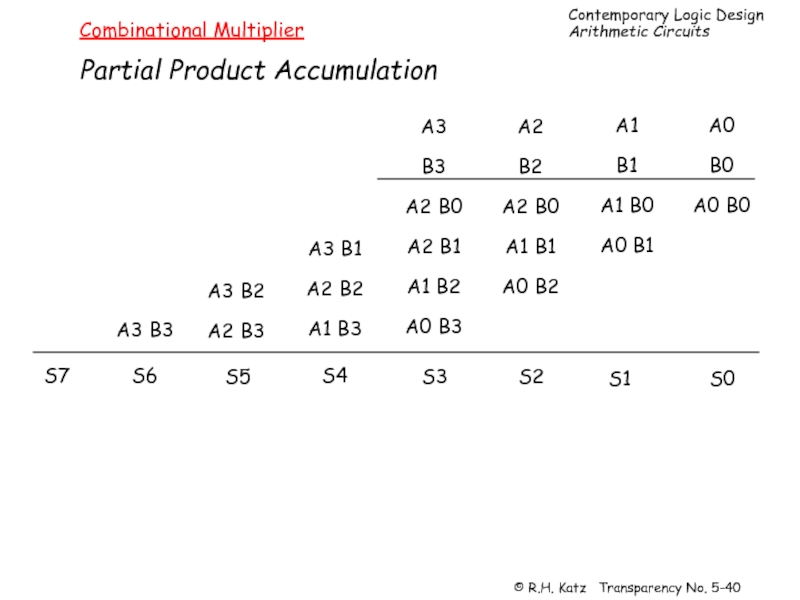
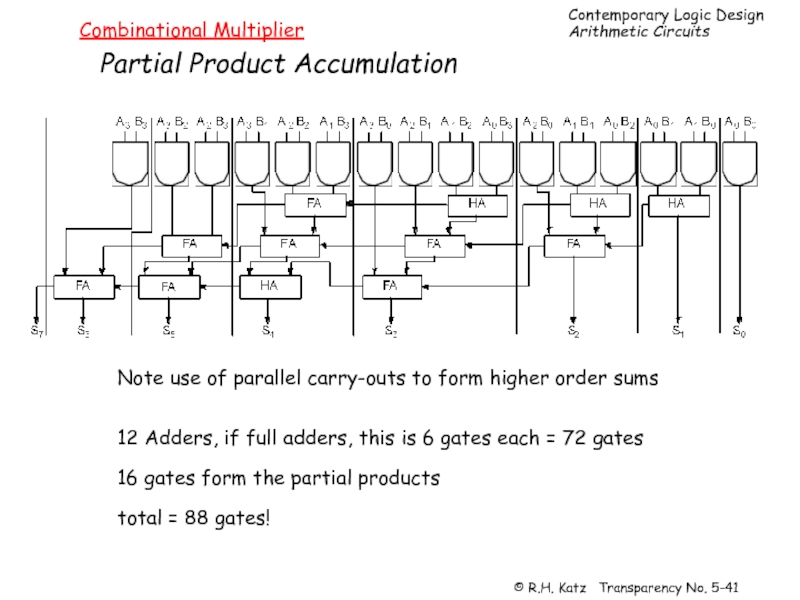
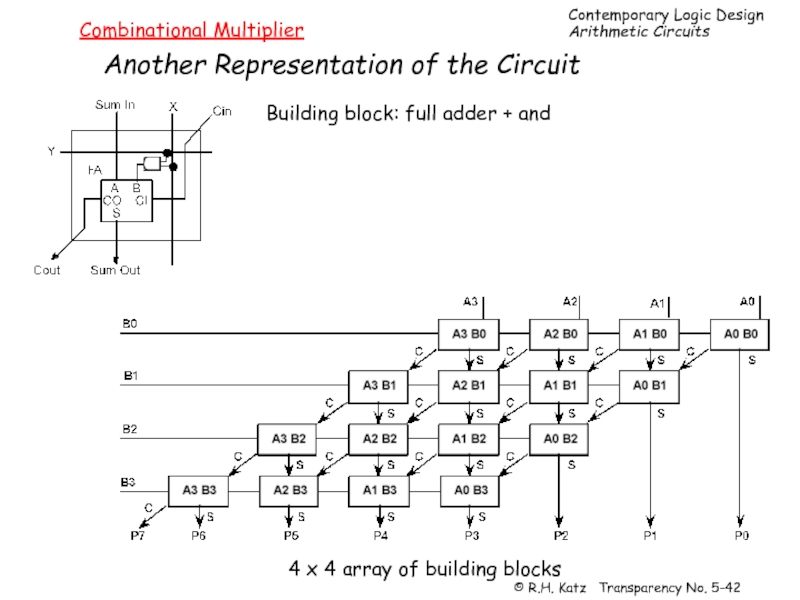
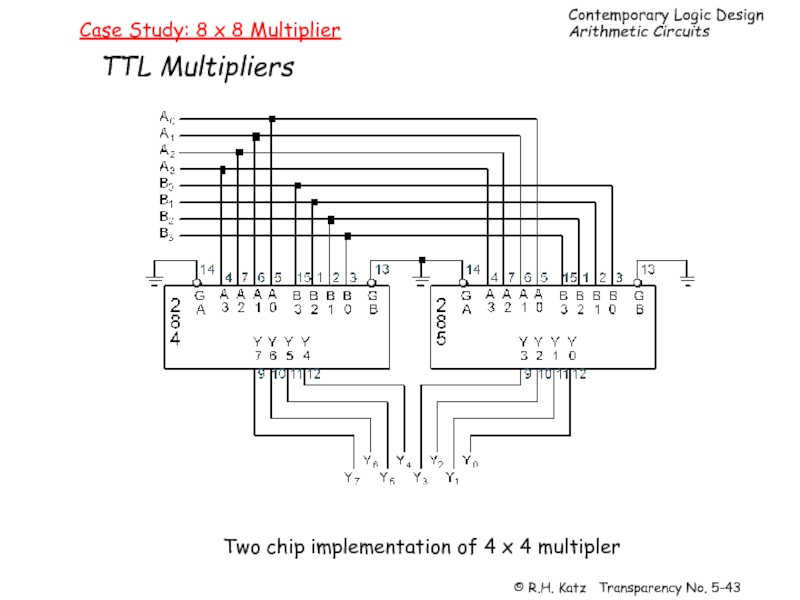
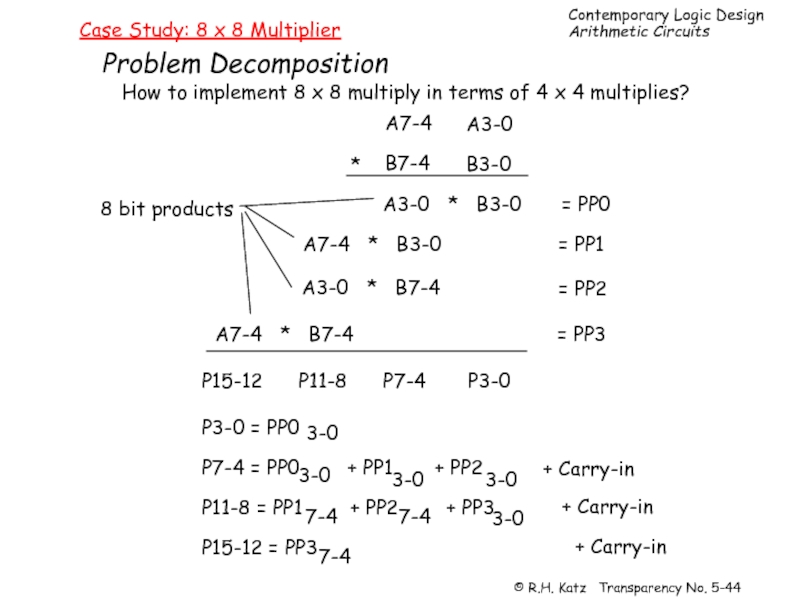
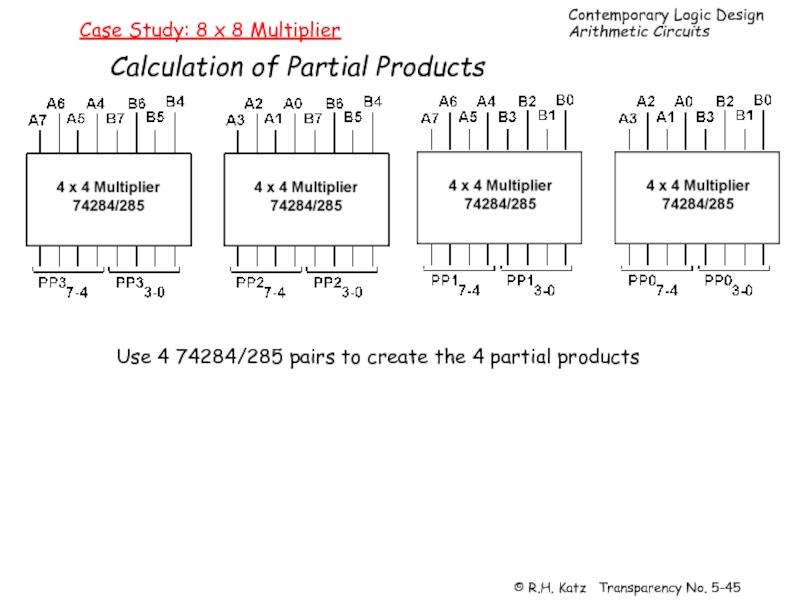
![Case Study: 8 x 8 MultiplierThree-At-A-Time AdderClever use of the Carry InputsSum A[3-0], B[3-0], C[3-0]:Two](/img/tmb/2/112673/e4fefcb06a9fa168be96dd681253fcb3-800x.jpg)
